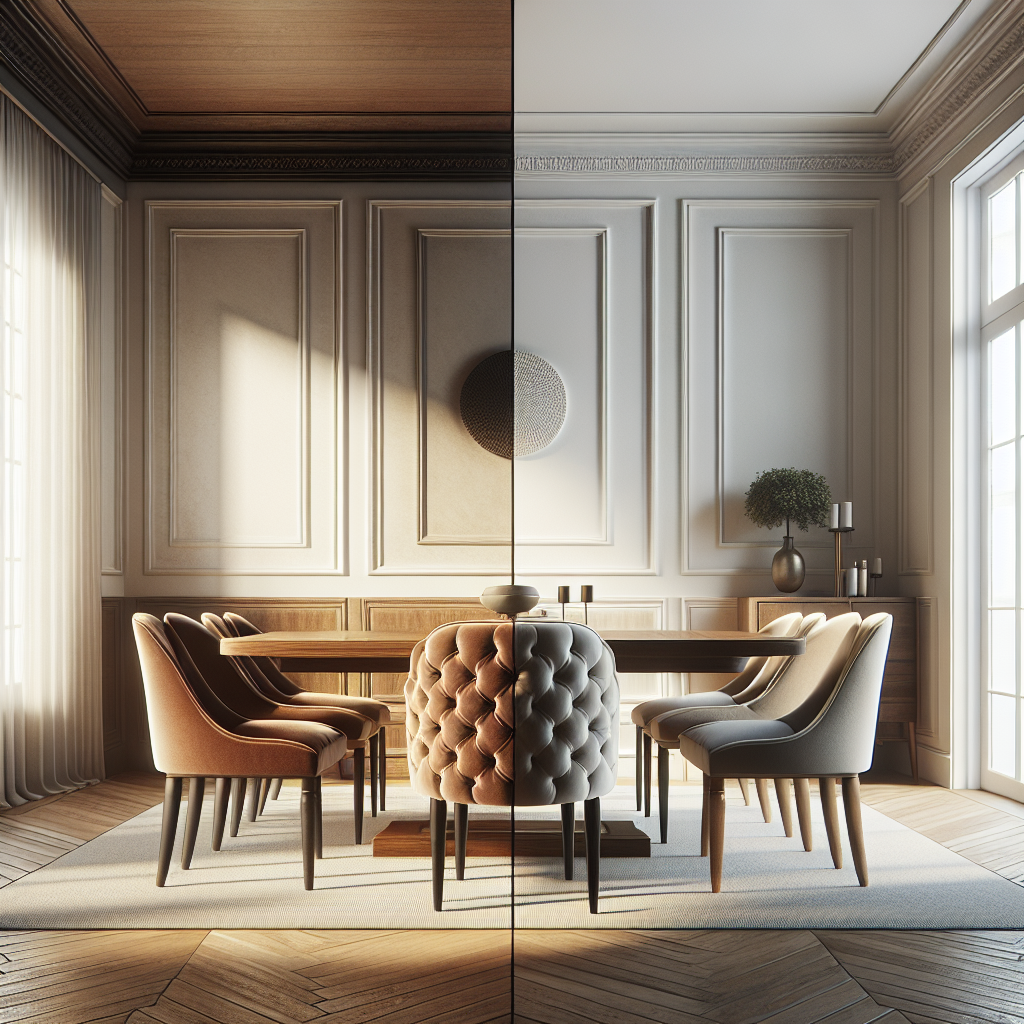Upholstered or Non-Upholstered Dining Chairs: Which Is Right For Me?
Upholstered or Non-Upholstered Dining Chairs: Which Is Right For Me?


Choosing the right seating for your dining space is not only about finding what looks good but also considering comfort, durability, maintenance, and style. Therefore, the decision to go for either upholstered or non-upholstered dining chairs needs careful consideration. This blog post provides an explicit comparison between the two types, complete with their definitions and key differences. We will also delve into their advantages, highlight their merits, and ultimately guide you to make an informed choice for your dining room chair preference.
Definition of Upholstered and Non-Upholstered Dining Chairs
Upholstered dining chairs come with padding, springs, webbing, and fabric or leather covers, providing a plush, comfortable seating experience. They are typically designed to match the rest of the dining room decor seamlessly. On the other hand, non-upholstered dining chairs, often made from solid wood or metal and without prominent padding, have varying designs from classic to modern. Comfort in non-upholstered chairs is typically achieved through ergonomic design rather than cushioning, making them a popular choice for side chairs in less traditional settings such as a kitchen table or eat-in counter. When shopping for dining chairs, it's important to consider the product page for information on lead times and delivery options. If you're looking for a statement piece to spruce up your traditional dining room, consider adding a dining armchair or a high-back chair with upholstered armrests.
Comparison of Upholstered and Non-Upholstered Dining Chairs
While upholstered dining chairs promise superior comfort and customisation, they may require more upkeep, primarily if made from stain-prone materials. Conversely, non-upholstered dining chairs shine in versatility and easy maintenance and come as budget-friendly choices for many. However, both types have their strengths and fit different lifestyle needs and design preferences. Let's dive deeper into their features and functionality, including the different types of materials used for both stools and non-upholstered chairs.
Comfort and Cushioning
● Upholstered dining chairs offer unquestionable comfort, with their padding supporting body contours, making sitting for extended periods easier. It makes these chairs an ideal choice for leisurely meals and long conversations.
● Non-upholstered dining chairs may not provide the same level of cushioning. However, ergonomic designs with curved backs or contoured seats make them reasonably comfortable. Their lack of padding means less risk of sinking too deep into the chair, thus fostering a good posture.
Design and Style
● The sky's the limit with upholstered chairs when it comes to design and style. With countless fabric or leather options and patterns, they're a decorator's dream and can be personalised to fit any interior decor.
● Non-upholstered chairs also present a broad selection of options like various material choices, from solid wood to metal, plastics, or a mixture for a hybrid look. They are simpler to blend with existing furniture due to the run-of-the-mill and classic designs.
Durability and Maintenance
● Upholstered chairs can withstand long-term use, provided they are cared for correctly. They may need professional cleaning, especially for fabric versions susceptible to stains and dust mites.
● Non-upholstered chairs are generally more durable and require less maintenance. Made from materials like metal, plastic, or wood, they can be simply wiped clean and don't hold odours. Also, their longevity could be increased when paired with removable and washable seat covers.
Advantages of Upholstered Dining Chairs
Upholstered dining chairs bring a soft, cosy, and lavish feel to the dining space. Their winning points lie in their enhanced comfort, customisable design, and sound-absorbing character, offering a multi-faceted package of advantages that cater to comfort-seeking, design-conscious users.
Enhanced Comfort
● Upholstered chairs' primary advantage is enhanced comfort, featuring generously padded seats and backs.
● You can enjoy your meal time or just relax for hours without feeling any discomfort or stiffness.
● The cushioned seating effectively absorbs the weight, reducing pressure on the sitter's body and thus delivering a higher level of comfort.
Customisable Design
● One of the best things about upholstered dining chairs is the vast array of design and customisation opportunities they present.
● Depending on your preference, you can choose from various upholstery materials, such as fabric, leather, or faux leather.
● They also offer a plethora of designs, colours, and patterns to match or contrast your dining room decor - making them a versatile choice for a personalised dining space.
Sound Absorption
An added advantage of upholstered chairs is that they are excellent at absorbing sound. This trait could be particularly useful in large dining spaces, where conversations and clattering cutlery could create echoes. The upholstered dining table found on these chairs can absorb much of this noise, contributing to a quieter, more tranquil dining environment.
Advantages of Non-Upholstered Dining Chairs
Non-upholstered dining chairs also come with their unique set of benefits, attracting customers for their easy maintenance, material versatility, and cost-effectiveness. These practical, comfortable, and often sleekly designed chairs can be an ideal choice for those valuing sans-fuss, long-lasting furniture.
Easy to Clean and Maintain
● Non-upholstered chairs excel in easy maintenance. Spills or stains can be quickly wiped clean without any worry of fabric staining.
● They resist wear and tear and are more resistant to scratches or damage from pets.
● They also don't retain allergens like dust mites or pet hair, making them a healthier choice for people with allergies.
Versatility in Material Selection
Non-upholstered chairs offer a wide variety of materials, including wood, metal, and plastics. Different materials influence the aesthetics, durability, comfort, and cost of the chair. For instance:
Wood: Offers rich, classic aesthetics, decent comfort, and long-lasting durability, but may come at a higher price.
Metal: Imparts an industrial or modern look, has high durability, and is generally more affordable.
Plastics: Provides a modern feel, decent comfort, lightweight, and cost-effective but may compromise on durability.
Budget-Friendly Options
● Non-upholstered chairs generally come at a lower cost compared to their upholstered counterparts, making them budget-friendly options, especially for large-scale replacements.
● The minimalistic design requires less raw material, which contributes to the lower pricing.
● While being cost-effective, they do not compromise on style or function, thus offering excellent value for money.
Choosing between upholstered and non-upholstered dining chairs depends heavily on individual preferences and needs. If comfort and a lavish sense of style top your priority list, upholstered chairs would be an appropriate choice. In contrast, if you value practicality, easy maintenance, and cost-effectiveness, non-upholstered models might suit you better.
